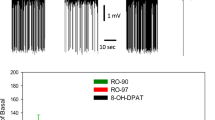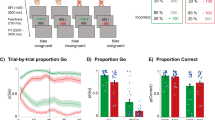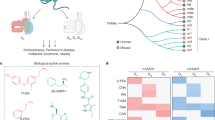Abstract
ALTHOUGH the enzymatic decarboxylation of amino acids is of substantial importance to biochemistry1, there are few inhibitors of the decarboxylase enzymes which combine activity with selectivity. Several of the amines formed by in vivo decarboxylation of amino acids (biogenic amines) have key roles in physiology. The neurotransmitters dopamine, 5-hydroxytryptamine, histamine and γ-aminobutyric acid result from such enzymatic decarboxylation; dopamine in turn serves as the precursor of noradrenaline2. The involvement of catecholamines in peripheral and central control of blood pressure has been the subject of many investigations; for example, elevated catecholamine levels were found in some of the 27 brain regions investigated in spontaneously hypertensive rats. Specifically, elevated noradrenaline and dopamine levels were found in regions implicated in the control of arterial blood pressure3. A widely reported biochemical theory of schizophrenia suggests disturbance of the dopaminergic system as the causative factor.4 Elevated histamine levels are believed to be involved in such diseases as allergy, hypersensitivity, gastric ulcer and inflammation5. Ornithine decarboxylase is also an important target for inhibition, as it is the initial enzyme in the biosynthesis of polyamines and increased levels of the latter have been associated with rapid cell division, including tumour growth6. Thus, selective inhibitors of these key enzymes could be of help in elucidating the complexities of neurophysiology and neurochemistry, as well as of service in medicine by correcting pathological levels of these agonists. We report here examples of the transformation of amino acids (C) into the corresponding substituted 3-fluoro-alanines (B), resulting in potent time-dependent decarboxylase inactivators (Table 1). In addition, we have prepared the fluoromethyl derivatives (D) corresponding to some of the amine products of these decarboxylases and find them also to be inactivators (Table 1).
This is a preview of subscription content, access via your institution
Access options
Subscribe to this journal
Receive 51 print issues and online access
$199.00 per year
only $3.90 per issue
Buy this article
- Purchase on SpringerLink
- Instant access to full article PDF
Prices may be subject to local taxes which are calculated during checkout
Similar content being viewed by others
References
Boeker, E. A. & Snell, E. E. Enzymes 6, 217–253 (1972).
Handbook of Psychopharmacology (eds Iversen, L. L., Iversen, S. D. & Snyder, S. H.) Vols 3 & 4 (Plenum, New York, 1975).
Versteeg, D. H. G. et al. Prog. Brain Res. 47, 111–116 (1977).
Snyder, S. H., Banerjee, S. P., Yamamura, H. I. & Greenberg, D. Science 184, 1243–1253 (1974).
Douglas, W. W. in The Pharmacological Basis of Therapeutics 5th edn (eds Goodman, L. S. & Gilman, A.) 590–629 (MacMillan, New York, 1975).
Russell, D. H. in Polyamines in Normal and Neoplastic Growth (Russell, D. H. ed.) 1–13 (Raven, New York, 1973).
Kollonitsch, J., Barash, L., Kahan, F. M. & Kropp, H. Nature 243, 346–347 (1973).
Kollonitsch, J. & Barash, L. J. Am. chem. Soc. 98, 5591–5593 (1976).
Kahan, F. M. & Kropp, H. 15th ICAAC, Washington, D.C., #100 (1975).
Wang, E. & Walsh, C. Biochemistry 17, 1313–1321 (1978).
Walsh, C. Horizons Biochem. Biophys. 3, 36–81 (1977).
Abeles, R. H. & Maycock, A. L. Acct. Chem. Res. 9, 313–319 (1976).
Rando, R. R. Acct. Chem. Res. 8, 281–288 (1975); Science 185, 320–324 (1974); Nature 250, 586–587 (1974).
Kollonitsch, J., Barash, L. & Doldouras, G. A. J. Am. chem. Soc. 92, 7494–7495 (1970).
Kollonitsch, J., Marburg, S. & Perkins, L. M. J. org. Chem. 40, 3808–3809 (1975).
Biochemical Preparations 4, 46–50 (Wiley, New York, 1955).
Taub, D. & Patchett, A. A. Tetrahedron Lett. 2745–2748 (1977).
Metcalf, B. W. & Jund, K. Tetrahedron Lett. 3689–3692 (1977).
Aster, S. D., Maycock, A. L., Patchett, A. A. & Taub, D. 175th National ACS Mtg, Anaheim, California, MEDI 58 (1978).
Metcalf, B. W., Jung, M. J., Lippert, B., Casara, P. & Danzin, C. 173rd National ACS Mtg New Orleans, Louisiana, MEDI 25 (1977).
Ellenbogen, L., Markley, E. & Taylor, R. J. Jr Biochem. Pharmac. 18, 683–685 (1969).
Lineweaver, H. & Burk, D. J. Am. chem. Soc. 56, 658–666 (1934).
Wu, J.-Y., Matsuda, T. & Roberts, E. J. biol. Chem. 248, 3029–3034 (1973).
Ono, M., Inoue, H., Suzuki, F. & Takeda, Y. Biochim. biophys. Acta 284, 285–297 (1972).
Mamont, P. S., Duchesne, M.-C., Grove, J. & Bey, P. Biochem. biophys. Res. Commun. 81, 58–66 (1978).
Christenson, J. G., Dairman, W. & Udenfriend, S. Archs Biochem. Biophys. 141, 356–367 (1970).
Håkanson, R. Biochem. Pharmac. 12, 1289–1296 (1963).
Chang, G. W. & Snell, E. S. Meth. Enzym. 17 B, 663–667 (1971).
Ulm, E. H. & Duggan, D. E. (in preparation).
Author information
Authors and Affiliations
Rights and permissions
About this article
Cite this article
KOLLONITSCH, J., PATCHETT, A., MARBURG, S. et al. Selective inhibitors of biosynthesis of aminergic neurotransmitters. Nature 274, 906–908 (1978). https://doi.org/10.1038/274906a0
Received:
Accepted:
Issue date:
DOI: https://doi.org/10.1038/274906a0
This article is cited by
-
Transcriptome analysis of Schizothorax oconnori (Cypriniformes: Cyprinidae) oocytes: The role of K+ in promoting yolk globule fusion and regulating oocyte maturation
Fish Physiology and Biochemistry (2024)
-
Enhanced Histaminergic Neurotransmission and Sleep-Wake Alterations, a Study in Histamine H3-Receptor Knock-Out Mice
Neuropsychopharmacology (2013)
-
Enhancing Effect of Zinc on l-Histidine Transport in Rat Lung Microvascular Endothelial Cells
Biological Trace Element Research (2011)
-
Involvement of central histaminergic and cholinergic systems in the morphine-induced increase in blood-brain barrier permeability to sodium fluorescein in mice
Naunyn-Schmiedeberg's Archives of Pharmacology (2004)
-
Submucosal microinfusion of endothelin and adrenaline mobilizes ECL‐cell histamine in rat stomach, and causes mucosal damage: a microdialysis study
British Journal of Pharmacology (2003)



